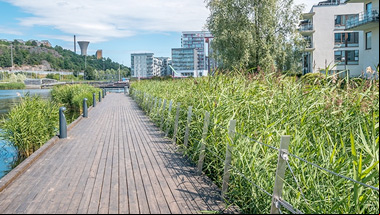New urban agenda 5l4h5c
How can sustainable urban development be promoted? 6x2q4s
The UN estimates that by 2050, 80% of the world will live in cities. Until then we have many challenges to overcome to make them more sustainable, inclusive and liveable places, as called for in the United Nations' New Urban Agenda.
The UN's New Urban Agenda proposes the transformation of cities into more liveable and sustainable spaces.
Cities occupy only 3% of the earth's surface but more than 4.3 billion people live in them, according to data from the United Nations (UN) and the World Bank. This figure is increasing rapidly, especially in Africa and Asia, making it ever more difficult for urban centres to offer prosperity to its inhabitants, who suffer problems including pollution, inequality, restricted mobility, poor access to housing or a lack of infrastructure and services.
What is the new urban agenda? 715n4w
The UN approved the New Urban Agenda (NUA) at the Habitat 3 summit on housing and urban development held in Quito (Ecuador) in 2016 to help promote a new global model for sustainable urban planning. The document advises countries on how to face the challenges of urbanisation and invites them to direct their efforts towards sustainable urban development, as the UN itself reflects in its goals for 2030 (SDG 11).
The New Urban Agenda — the successor to the Habitat Agenda and the 1996 Istanbul Declaration — establishes how cities should be transformed to be habitable, inclusive, healthy, sustainable, safe, orderly, compact and resilient to natural phenomena. At the same time, it urges changes to the way they are planned, developed, governed and istered by acting through design, legislation, local economic policies and state urban planning policies.
Objectives of the New Urban Agenda 3lq43
A new approach for un-habitat
-
Reduce inequality in communities both in urban and rural environments.
-
Promote greater shared prosperity for cities and regions.
-
Strengthen climate action and improve the urban environment.
-
Implement effective prevention and response policies to combat urban crises.
 SEE INFOGRAPHIC: Objectives of the New Urban Agenda [PDF]
SEE INFOGRAPHIC: Objectives of the New Urban Agenda [PDF]
The importance of environmental urbanism
The environment occupies a key place in the New Urban Agenda and new sustainable urbanism. Cities need to invest in green spaces, renewable energy, bioarchitecture and policies to promote recycling and responsible consumption in order to reduce pollution and make them healthier and more liveable places.
Environmental urbanism is driving the energy transition towards a less carbon-dependent model that more effectively combats climate change by reducing CO2 emissions. This conception of cities promotes biodiversity, efficient water use, soil and aquifer protection, the conservation of flora and fauna, public transport use and sustainable mobility, among other initiatives. In this way the New Urban Agenda is ing other concrete measures such as, for example, the regulation of building height, the preservation of open areas and the allocation of between 30 and 50% of the land to public spaces.
6b1x1e
The 10 commandments of the habitable city 1a5n1k
Source: Hugo Macdonald, author of 'How to live in the City'.
 SEE INFOGRAPHIC: The 10 commandments of the habitable city [PDF]
SEE INFOGRAPHIC: The 10 commandments of the habitable city [PDF]
The challenges facing sustainable town planning 2l1o1w
At the end of 2018, the Davos Forum revealed that, despite the progress made on the New Urban Agenda in the world, there are notable differences between countries and regions. The success of this global initiative requires the effort and cooperation of all the istrations involved as well as social awareness, financial resources, capacity development, innovation and commitment.
In 2022, there has again been talk about the need for each region to take its own measures, because in different parts of the world the responses must be diverse. In addition, cities that were already integrated and ed this change do not send their reports on a regular basis. This is why, once again, 90 countries recommitted themselves to the implementation of the urban agenda.
The World Economic Forum pointed out the main challenges facing the new sustainable town planning roap:
- The New Urban Agenda lacks predefined indicators to measure its progress and leaves the choice and monitoring of results to local governments.
- It takes time, training, specialisation and concerted effort to monitor and correctly evaluate the progress attributable to the agenda.
- Favourable institutional frameworks are needed with adequate regulation, coordination mechanisms at all levels and a clear, able government structure.
- Greater participation by local governments is appropriate, assuming more weight, control and power when making decisions.
- The transformation of cities requires greater cooperation and dialogue between public authorities and the private sector, educational bodies and civil society.


















